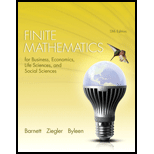
Concept explainers
In Problems 17-24, simplify and write answers using positive exponents only. All variables represent positive real numbers.
Want to see the full answer?
Check out a sample textbook solution
Chapter DPT Solutions
Finite Mathematics for Business, Economics, Life Sciences and Social Sciences Plus NEW MyLab Math with Pearson eText -- Access Card Package (13th Edition)
Additional Math Textbook Solutions
Thinking Mathematically (6th Edition)
University Calculus: Early Transcendentals (4th Edition)
Calculus: Early Transcendentals (2nd Edition)
Pre-Algebra Student Edition
Elementary Statistics (13th Edition)
- COMPLETE THREE-VIEW ORTHOGRAPHIC SKETCHES OF THE FOLLOWING OBJECTS USE ORTHO GRID PAPER. Drawn By:arrow_forward7.1. If X has an exponential distribution with the parameter 0, use the distribution function technique to find the probability density of the random variable Y = ln X. bilaga in dwreatarrow_forwardNo chatgpt pls will upvotearrow_forward
- 2 Q/ Let d₂ +d, di, d2: R² XR² R² defined as follow ((x+x), (2, 1) = √(x-2)² + (x_wx • d₁ ((x,y), (z, w)) = max {1x-z\, \y-w\} • 1 1 dq ((x,y), (Z, W)) = \ x=2\+\-w| 2 • show that dod₁, d₂ are equivalent? 2arrow_forward2 +d, di, d2: R² XR² > R² defined as follow Q/ Let d₂ 2/ d((x+x), (2, 1)) = √(x-2)² + (x-wsc • d₁ ((x,y), (z, w)) = max {| x-z\, \y-w\} • d₂ ((x, y), (Z, W)) = 1x-21+ \y-w| 2 • show that ddi, d₂ are equivalent? އarrow_forwardNumerical anarrow_forward
 Algebra: Structure And Method, Book 1AlgebraISBN:9780395977224Author:Richard G. Brown, Mary P. Dolciani, Robert H. Sorgenfrey, William L. ColePublisher:McDougal Littell
Algebra: Structure And Method, Book 1AlgebraISBN:9780395977224Author:Richard G. Brown, Mary P. Dolciani, Robert H. Sorgenfrey, William L. ColePublisher:McDougal Littell Holt Mcdougal Larson Pre-algebra: Student Edition...AlgebraISBN:9780547587776Author:HOLT MCDOUGALPublisher:HOLT MCDOUGAL
Holt Mcdougal Larson Pre-algebra: Student Edition...AlgebraISBN:9780547587776Author:HOLT MCDOUGALPublisher:HOLT MCDOUGAL Elementary AlgebraAlgebraISBN:9780998625713Author:Lynn Marecek, MaryAnne Anthony-SmithPublisher:OpenStax - Rice University
Elementary AlgebraAlgebraISBN:9780998625713Author:Lynn Marecek, MaryAnne Anthony-SmithPublisher:OpenStax - Rice University

 Glencoe Algebra 1, Student Edition, 9780079039897...AlgebraISBN:9780079039897Author:CarterPublisher:McGraw Hill
Glencoe Algebra 1, Student Edition, 9780079039897...AlgebraISBN:9780079039897Author:CarterPublisher:McGraw Hill





